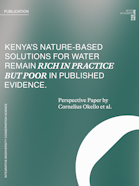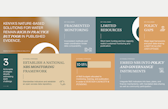From practice to public evidence: monitoring nature-based solutions for Kenya’s water
News
Publish date: November 3, 2025

From practice to public evidence: monitoring nature-based solutions for Kenya’s water
News
Publish date: November 3, 2025
Across Kenya, nature-based solutions (NbS) such as restoring wetlands, building sand dams, and supporting rangeland measures are being used to strengthen water security and biodiversity. Yet the monitoring behind these efforts is mostly found in reports and dashboards rather than in the peer-reviewed record. That makes results difficult to compare and slows their uptake in planning and finance.
A new open-access perspective in Frontiers in Environmental Science examines how to close this gap. Authored by Cornelius Okello, Simangele Sithole, and Margaret Awuor Owuor, the paper traces the reasons monitoring seldom becomes public evidence: uneven indicators, fragmented responsibilities, short project cycles, capacity constraints, and limited incentives for sharing data.

The authors propose three pillars that work together:
Adaptive, co-designed monitoring through living labs connects local practice to agreed protocols and continuous learning, so datasets are consistent over time and anchored in place.
A national, open NbS repository built on FAIR principles makes vegetation, hydrology, and household water metrics findable, citable, and verifiable, which allows results to be checked, compared, and reused beyond single projects.
Standardized indicators embedded in planning and finance ensure county plans, national strategies, and outcome-based instruments track performance in the same way—linking budgets to outcomes rather than activities.
The paper also points to practical enablers: long-term monitoring, evaluation, and learning budgets; open-access publishing and co-authorship with practitioners and county officers; and careful attention to land tenure and free, prior, and informed consent to sustain monitoring access and trust.
Read alongside our work in Kenya, the emphasis is familiar—pair grounded practice with shared evidence so decisions travel across levels and endure.
Ultimately, the value of Kenya’s nature-based solutions will be judged not only by what is built, but by what is learned and shared. Turning monitoring into public evidence—co-designed, comparable, and open—gives communities and authorities a common reference point for decisions and finance. That is how local practice informs policy, and how water governance becomes both more accountable and more resilient over time.